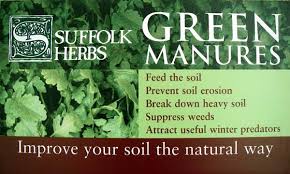Green manure is an (intermediate) crop that receives fertilizer, suppresses weeds and prevents leaching, and is being plowed under to make organic matter (humus) in the soil.
 Commonly used as green manure are legumes as lupine, vetch or clover species who with the help of symbiotic bacteria (Rhizobium) bind nitrogen from the air and so increase the nitrogen content of the soil after incorporation.
Commonly used as green manure are legumes as lupine, vetch or clover species who with the help of symbiotic bacteria (Rhizobium) bind nitrogen from the air and so increase the nitrogen content of the soil after incorporation.
Green manure is not harvested but incorporated. The usefulness of this:
More diversity, they keep the humus content to standard, nourish the soil, improve soil structure by rooting, prevent leaching and lay as a catch crop nitrogen and minerals, suppress weeds, keep the soil covered.
Also grasses, rye, yellow mustard and others are used as green manure.
Some of our expression for mixed or multiple cropping (and intercropping) don’t have an English equivalent, so I’ll try to introduce the concept.
A deck crop is the crop that is sown with another crop and grows faster. The deck crop protect the other crop against e.g. drought and weeds.
This other crop can be a ground cover or green manure. Among cereal for example is sown as undersow clover (or ryegrass, pea). Choose plants that grow not too high in the deck crop to avoid problems during harvest. Some under crops lure beneficial insects.
A stubble crop is sown late in the year, sometimes with the main crop (deck crop) and comes to develop after harvesting between the stubbles.
Sometimes is after harvesting the crop (e.g. rye) sown among the stubble (e.g. spurrey).
It serves as fodder and /or green manure.
The turnip (Brassica rapa var. Rapa) is widely used for this apply. This stubble turnips, swedes or turnip rape, canola, field mustard, are rape turnips, which were often in August sown after the harvest and were fed fresh from October to December to the cattle. Now, turnips, which make no tuber, are still sown as green manure.
A catch crop is a fast growing crop that is grown with or between (in time or space) the production of a main crop. It may therefore be an intermediate crop between successive rows, harvests or seasons (e.g, between or after corn). Catch crops make efficient use of the available space.
Radish is often suitable for this, since it only requires 25 to 30 days from germination to harvest.
Catch crops are also used to prevent the leaching of minerals (carbon and soil) (especially in autumn and winter) and keep them fixed or in the ground. And actually mainly to ’catch' nitrogen.
Also along roadsides and waterways is a (mandatory) cultivation-free strip often sown with a catch crop to catch and limit spraying drift and emission the open water.
Grass, green manure, grains, etc. are used as a catch crop.
The farmers always complain. Either it is too wet, or it is too dry, or the price of potatoes and wheat too low, or the delivery period of the Mercedes too long.
